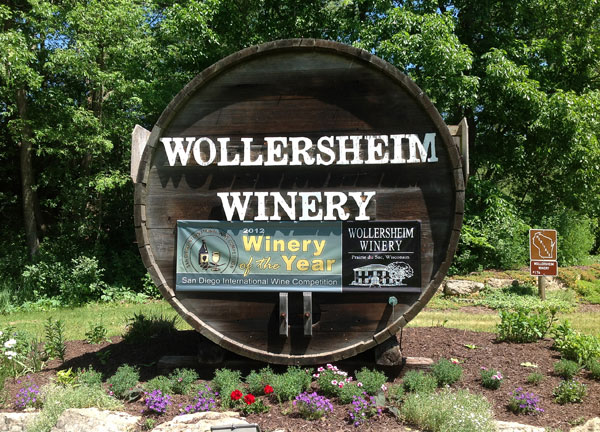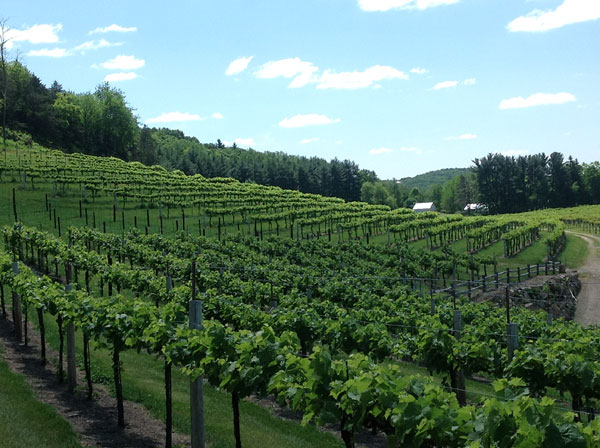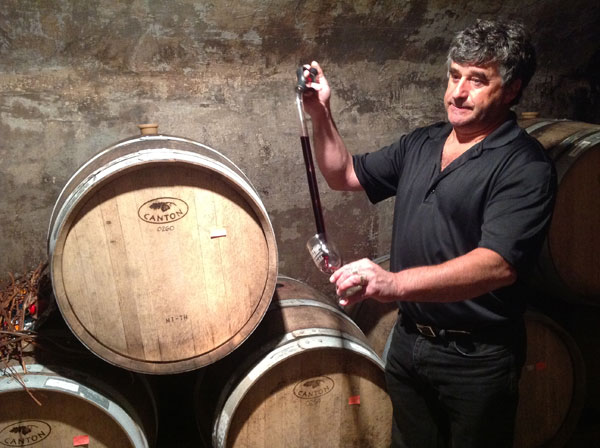
Nearly 30 years ago, Philippe Coquard left France to make wine in Wisconsin. Leaving behind a family full of winemakers, he came to Prairie du Sac on an agricultural exchange program. Now he and wife Julie Coquard (née Wollersheim, daughter of proprietors Robert and JoAnn) preside over Wollersheim Winery.
We know what people have historically thought of wine from Wisconsin, the land of beer and brandy: They’re all disgusting plonk like those fruit wines from Door County, right? That may have been the case, but lately we’ve detected a shift.
First, this author was gobsmacked by the bright and nuanced Wollersheim Prairie Blush at the 2011 International Cold Climate Wine Competition where we awarded it a Double Gold medal. Then, Wollersheim was awarded Winery of the Year at the 2012 San Diego International Wine Competition after raking in Platinum medals for six wines. Finally, a Decanter columnist verified Wollersheim’s prowess by recounting their equally impressive performance at the 2012 International Eastern Wine Competition.
What gives? When did Wollersheim turn the corner? As best we can tell, the answer lies with Prairie Fumé.
Now about as pervasive as a Wisconsin wine can be, Prairie Fumé is a light white full of lip-smacking citrus from New York-grown Seyval Blanc grapes. It’s an undeniably fresh, unobtrusive, and effortless sipping wine that accounts for a third of Wollersheim’s output (they made around 70,000 gallons of Prairie Fumé last year). At $9 retail, it would instantly replace this author’s everyday Chilean Sauvignon Blanc if they distributed in Minnesota.

First released in 1989, Prairie Fumé’s success is what allowed Wollersheim to become the regional behemoth it is today (it’s the highest-volume winery in Wisconsin with 1.1 million bottles produced last year). It allowed for the purchase of new equipment and facilities, and greater investment in making quality wines in varying styles.
Those that think Wisconsin’s red wine is all vapid sugar water should be lining up to try Wollersheim’s Domaine Reserve ($20), made from the 40-year-old Marechal Foch vines on the steepest hill behind the winery. “We’ve been making it since, I think, ’78. We changed the name [to Domaine Reserve] in ’81.” says Julie, as we survey a case of 30-year-old wine medals.
They’ve been able to coax a deep, enveloping richness out of these Foch grapes, not just due to the age of the vines, but also by means of a “green harvest” – the elimination of slower-ripening bunches midway through the growing season, allowing the vine’s full vigor to be concentrated in the remaining grapes. A barrel sample of their 2011, in oak since October, had a delightful blackberry-toffee-allspice way about it.
Philippe (below) makes no excuses about working with the less-revered cold climate grapes as opposed to traditional European varieties. “It isn’t that much different. At the end of the day, you’re still making wine,” he says. “You still have acids and sugars, some tannin … the levels may be different, but the product is the same.”

Their specialty, Marechal Foch, is a light, small-berried French-American hybrid grape. Foch is often in the periphery among cold-climate wine grapes. Not many wineries place a premium on it, and if anything, it’s currently losing favor among local growers. New red vine planting, especially in Minnesota, is tending toward more recently engineered varieties like Marquette and Frontenac.
“We tried a lot of other things,” says Julie of her parents’ early plantings. “We had Baco Noir, Chelois, and Seyval, but they weren’t reliable, in terms of dealing with the humidity in summer, then the cold over the winter, and in terms of the style of wines. Foch worked the best – we really learned how to work with it. Now we make at least five different styles of it.”
The Minnesota Grape Growers Association notes that Foch produces wines “Burgundian” in character. Perhaps this is because it takes well to carbonic maceration – a technique that involves fermenting whole clusters of grapes under pressure and is prominently used in Coquard’s native Beaujolais. He uses it for a few Foch bottlings, most obviously a Beaujolais Nouveau-style wine that gets released right before Thanksgiving just like the real stuff.

The newest notable development for Wollersheim is their first run of brandy, targeted for release in April 2013. Wisconsin changed a law two years ago prohibiting wineries from distilling and vice versa. Wollersheim applied for a distiller’s permit right away and bought a beautiful copper pot still from Portugal.
Distilled from estate-grown St. Pepin grapes, the first batch is about halfway through its planned two-year stint in Wisconsin oak. Coquard is experimenting with five different toast levels (the extent of char on the inside of the barrel) in the hopes that after a few batches he’ll have zeroed in on the perfect barrel treatment.
Their tasting room is open daily, just an easy half hour northwest of Madison. Besides the Fumé, two other $9 standouts to pick up on your visit are the aforementioned Prairie Blush and their racy Dry Riesling (the 2012 International Eastern Wine Competition Best of Show) full of tart, zesty green tree fruit notes.
Wollersheim is now in its 40th year of production (practically ancient for a winery around here), and they seem to be hitting their stride. They do the light and flirty sweet sips Midwesterns have come to expect from local wine, but in a balanced manner you might not expect. And their more serious wines – the Reserve, icewine, lees-aged Chardonnay, and a particularly stunning tawny port – show wonderful integrity and reflect the true potential of cold climate winemaking.
Wollersheim Winery
Wisconsin Winery
7876 State Rd 188
Prairie du Sac, WI 53578
608.643.6515
Tasting Room Hours: 10am-5pm daily, except select major holidays

Many years ago we came to your unknown winery. We loved your Baco Noir. We were young with 2 small children and little money. But we use to buy a case of Baco Noir for those nights when kids, work, etc was just one glass away from comfort time for my husband and I. Well our daughter remember those nights. So when she was in Binney, she spotted your label. It’s wasn’t the Noir, but she gave us a bottle for Christmas. Which we will open on New Year’s Day. We are wine drinkers now. I remember I kept 1 bottle for good memories. So I looked for it in our cool cellar and there I found our 1 bottle of unopened 1973 Baco Noir. It holds so many memories within that bottle and I guess for my adult children too. I don’t think I could open it at this time but maybe one day. I just wanted to share this memory with you. You not only have made wine, but wonderful events in our life’s.
HAPPY 2015 and enjoy each day.